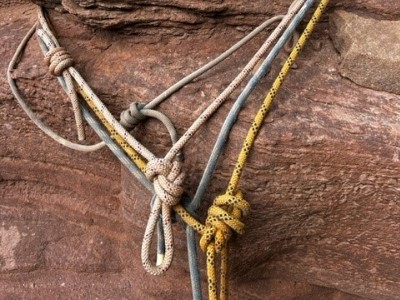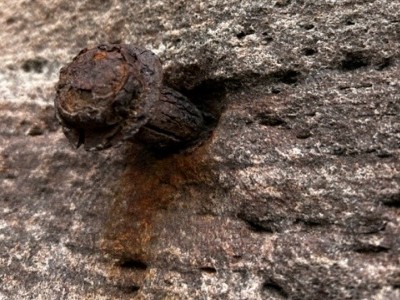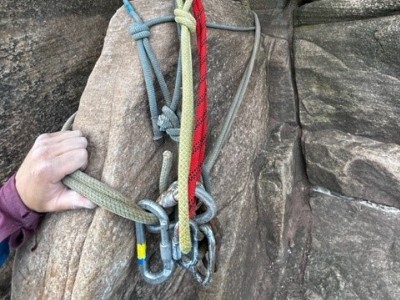Monday 9th October 2023, 2:06pm

A project is proposed to clean up the Old Man of Hoy, removing and disposing of decades of rotting pegs, old rusted bolts and unsightly tat that is making this sea stack look a mess, when it should be a pleasure to climb. This is with the agreement of the landowner, RSPB, who look after the extensive breeding seabird colony here.
In addition, the abseil stations for descent will be cleaned, installing modern and much more durable options, avoiding the need to add and leave further climbing rubbish.
Opinion is sought from the climbing community on this clean-up initiative.
What’s the problem?
The Old Man of Hoy – a classic climb, is a mess of old, rotting gear that has been left behind at each belay and accumulated over decades of use. The problem is the constant use of very old pre-placed gear and the use of increasing amounts of slings that is unsightly and is against the trad ethic of ‘leaving no trace’.
Many of the fixed belays are made up of rotten tat tied to rotten tat, tied off to rotten bolts. A meter or two of recently added fresh cord may reassure a climber that a 60m free hanging abseil will be safe, but the quality and reliability of what that cord is tied to cannot easily be judged.

An ascent of the Old Man of Hoy should be a classic adventure, a pilgrimage for UK trad climbers, not a game of abseil roulette following success on the summit.
In full agreement with the landowner, RSPB, the plan is to massively reduce the human debris and make descent from the stack safer by removing the uncertainty of whether an abseil anchor will fail.
With the particular sea stack issue of abseil descent being unavoidable, and the increasing popularity of the climb and therefore an increasing amount of unsightly climbing rubbish having to be left behind, the aim of the project is to remove decades of these rotting pegs, old rusted bolts and unsightly tat, and replace them with something that will be less unsightly, will last longer and whose quality can easily judged by climbers
The need for the abseil stations
The only safe way to descend or retreat from the stack is by fixed abseil stations solo-down climb (or parachute!) Some of the abseil stations are also used as belay stations in ascent. Some of the ascent belays are on leader placed protection and nothing will be done at these locations other than efforts made to remove the heads of rusted away nuts to open up the cracks once again for placements.

Objectives
On Belay Stations:
On Abseil Stations:
Current condition and action proposed
Current anchors for the original route are:
All of the above is done in a voluntary capacity at their own cost and time, with the full support of the landowner.
The intention is to make the stack a joy to climb and safe to descend.